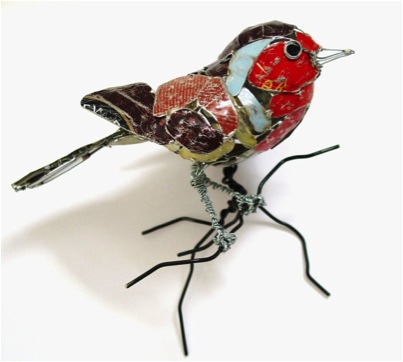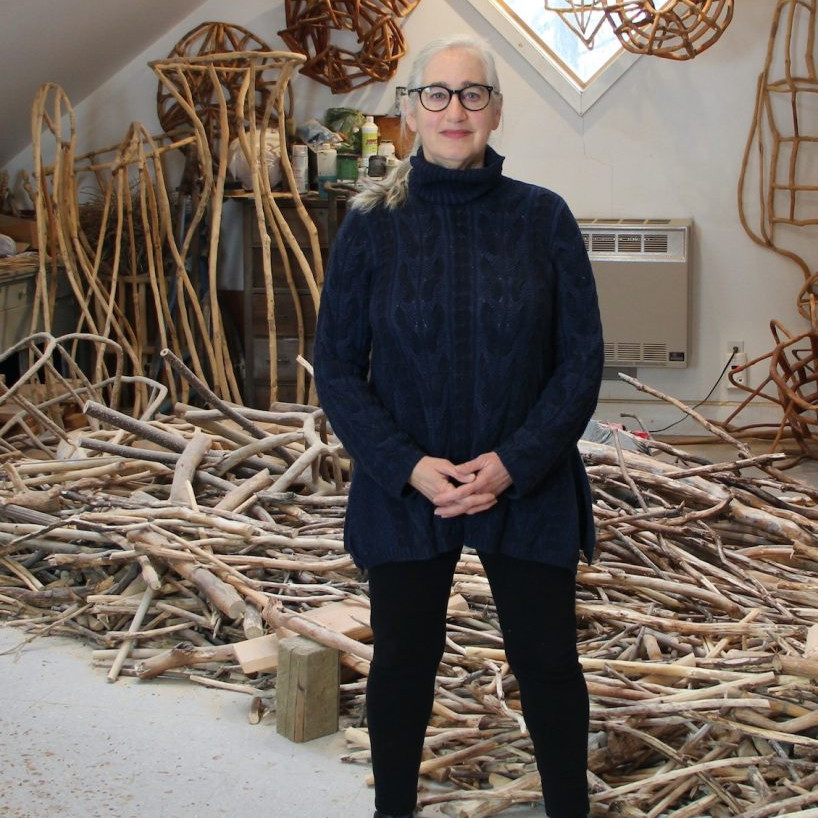Barbara Franc Sculptor - London, UK
Your initial training included life drawing, how important is this to your current work?
I used to attend Morley Art College for one a day a week in the early days whilst I was still working with the BBC. My tutors included Maggie Hambling and John Bellany, both well established artists here in the UK. They were both very passionate about drawing from life and encouraged students to express themselves through whatever medium they chose to use.
Life drawing did play an important part in my own work at the time but I now tend not to sketch on a flat surface at all and find it more immediate to draw with wire. I think that’s just because I find I look at things three dimensionally and prefer to recreate the form straight away, I’m just too impatient to translate it into 2D first.
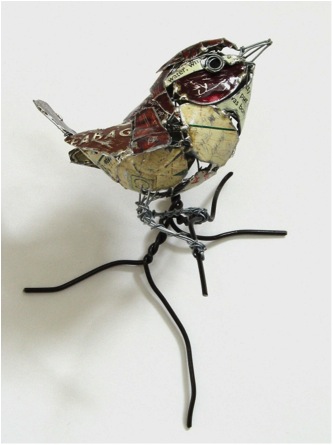
Mary Orrom is your mentor; can you explain the value of having a mentor as an artist?
I am very lucky in the fact that every Thursday I meet up at Mary Orrom’s house with a group of other sculptors and we just ‘workshop’ together with Mary being the guiding force. She is hugely inspirational and will give just the right advice at the right time about a developing piece of work. Her own work is constantly innovative and boundary pushing, she successfully uses materials in a very intuitive, beautiful and thought provoking way.
I owe a lot to my long standing friendship with her.
One inspiration of your current works, is based on an injured crow “Edgar” can you explain how this relationship came about and how it come into your work?
A couple of years ago, Edgar literally just walked into our lives. I was at the front of my house sweeping away some leaves when a black, tatty crow just walked out from under our car and stood there looking at me. I then heard a lot of ‘cawing’ in the surrounding trees and two other crows started to fly down to mob him. As this crow in front of me seemed unable to fly and was not afraid of me, I picked him up and checked him over to see if he was injured but could find nothing wrong with him that was obvious.
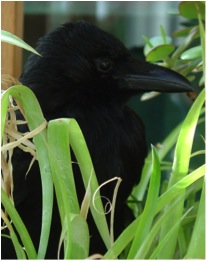
He seemed remarkably tame and I wondered if he had been hand reared, so we took him into our back garden and fed him to see if he would get any stronger.
This went on for a couple of days during which time he would come into our conservatory when called, he was quite perky but still made no attempt to fly.
During this time I contacted several wild animal rescue sites, they all offered advice but said they could not take him in as he was so tame and would not be able to be released back to the wild. I then found some wonderful people who rescue crows and other corvids and if they cannot go back to the wild will bring them into their family as pets, one lady even had her Jackdaw talk down the phone to me!
So Edgar went to live up North with some other crows, his new owner had him for a while and eventually he died from a lung infection, she estimated that he was probably about 30 years old. She then explained to me that after having looked after him she was fairly sure that he was a wild bird and that some crows are smart enough to turn to human help when they start to get old. He had been mobbed by his fellow crows because of his age and frailty, nature at its cruellest.
It had been such a privilege to have had him in our lives for even a short time, I made a whole series of sculptures based on him all from old black plastic that had been distorted by heat. It just seemed the right material to use for that wonderful but hopelessly tatty old bird that stole our hearts.
The pictures here are of the two pieces that I have kept here at home.
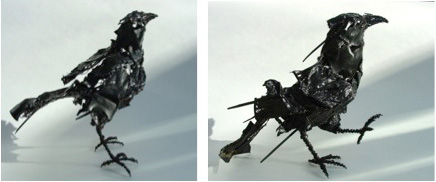
As well as 3D work you also do 2D pieces. Can you tell us about both techniques?
The 2D pieces I have made are not totally flat as I do allow the tin to emerge slightly from the surface, for example the ruff collars of the Cholmondely Sisters. This particular piece is my own copy of one of my favourite paintings that hangs in Tate Britain, I love the composition of this work, and it is so different from anything else painted in that era and has a wonderful sense of humour. What a shame that the painter still remains anonymous.
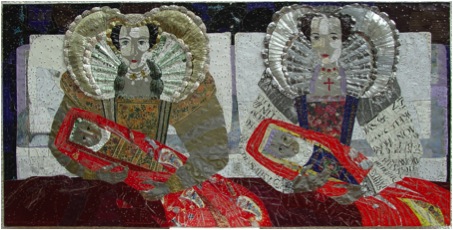
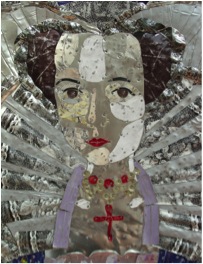
I worked on this particular piece whilst suffering from the recent bereavement of my father, it really helped me get through that difficult time and appreciate that life will always run its course and start anew. The technique to make a piece like this is fairly straightforward, I mark out the picture on a large piece of wood, cut pieces of tin to shape and just tack them onto the wood base, the fun is finding the right colour and also injecting some humour with the choice selection of words from script on the recycled tin.
One baby has ‘jelly baby’ and sweet tins on its body, the other the words ‘celebration’, I thought the use of champagne packaging on one of the mothers was also appropriate.
This piece is now in a private collection and I do admit to missing it.
Matisse is another of my favourite artists and I have made homage pictures of his works as well.
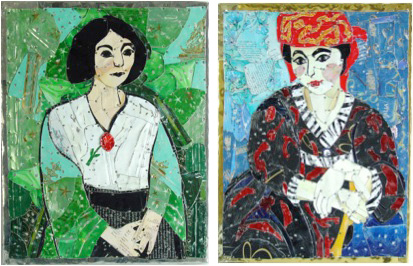
Can you explain about your British Birds and birds from further away?
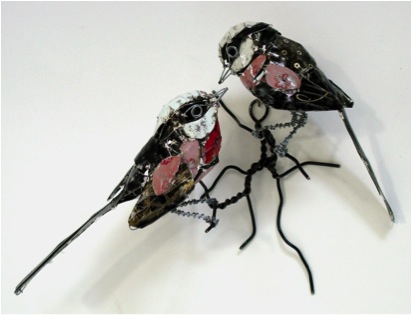
The bird’s series came about when One Church Street Gallery offered me a solo show but asked that the theme be ‘birds’. I took to this idea like the proverbial ‘duck’ and have never looked back; I really enjoy the form and endless diversity in this animal group.
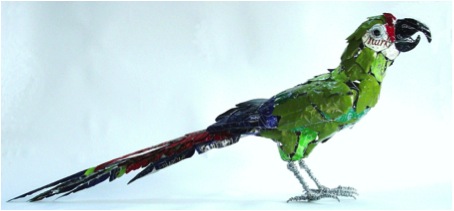
My use of coloured tin dates back to this show as I wanted a medium to express the wide range in plumage. I try to make most of the birds approximately life size as I think that scale suits them the best.
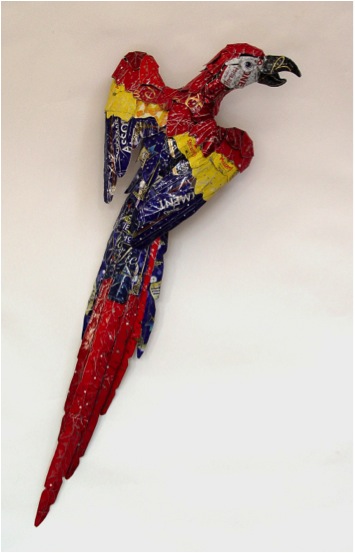
Where do you get your recycled materials from?
I find a lot of my pieces literally on the streets, charity shops, car boot sales and I have a small army of my mother-in–law’s friends who tirelessly supply me with old biscuit tins!
Looking at your Highland Hares the use of recycled materials is more evident please discuss?
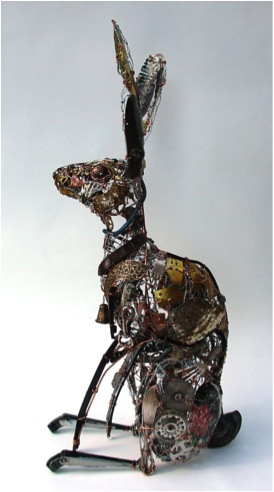
I have two methods of working at the moment, the first as described for the birds with a fine wire armature to which tin is soldered onto, the second method is similar but far more time consuming. I will make a loose armature from wire netting and start to add bits and pieces of detritus to it with copper wire. Windscreen wiper blades might become a leg, an old colander becomes a rib cage, a draught excluder becomes a horse’s ‘hogged’ mane. I will spread my work surface with hundreds of found objects and select from them. I could spend a whole day just offering up pieces to the sculpture and still not be happy with the result and then suddenly the right piece presents itself!
Working with recycled and found objects makes me accept the individual qualities of the various materials they are made of, I have to adapt to them, not the other way round. It’s a bit like assembling a jigsaw with no picture and all the pieces keep changing shape before I can get them under some sort of control!
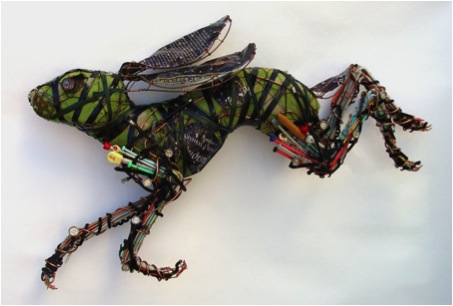
How do you decide on an animal or bird to do a series?
The choice of what I work on can come down to a straightforward commission, or I might go on a walk and see something like a Hare bounding in front or I might find a bottle top that suggests a cat’s eye to me.
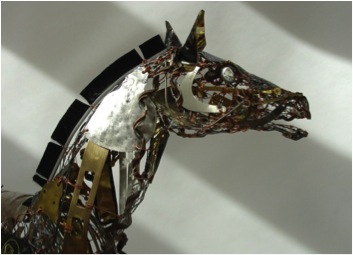
Where does your inspiration for your Kimonos come from? Can you please explain how this work is done and expand on how you have also framed some of this work?
The kimono series started after my daughter went on a trip to Japan and brought one of these beautiful garments back for me. I went to the V&A Museum to research their collection, I was intrigued not only by the garments but also how their display. They were suspended by poles through the armholes and I just find this a really pleasing sculptural form, it was as if the garments took on a life of their own whilst patiently waiting to be worn.
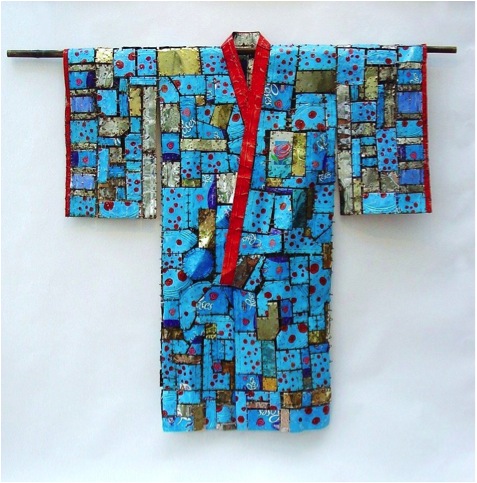
I started to construct my own kimonos, using my one for the dressmaking pattern, the life size ones made from pieces of tin stitched together with copper wire and hung from bamboo poles. After the large garments I then made a series of small ones that are either individually framed or as a group.
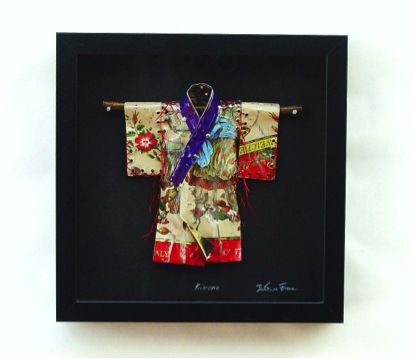
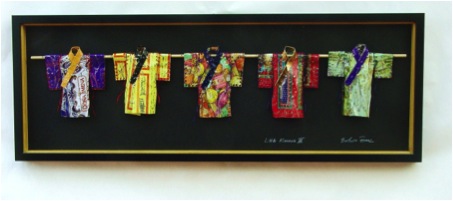
When you have a solo exhibition what lead time do you need?
It is always wonderful to be offered a solo exhibition and it depends on the venue as to how many pieces they would like and what size but I do like to have a year to be able to think and plan out what I would enjoy making for the show.
You have an upcoming exhibition, is this the only work you will do until it is complete or do you add other work for diversity?
With my upcoming show I will almost exclusively work towards it with perhaps now and again doing some smaller pieces to commission for a bit of variety and also income!
Do you exhibit outside the UK – would you like to?
I haven’t exhibited outside the UK and apart from the obvious logistics of transporting work, customs etc. I think I would welcome the challenge of showing to a wider audience. I do take commissions from abroad I am just about to make a pair of Chickadees to fly off to Canada.
You do commissions, can you explain how someone can give you a commission and the criteria you have to accepting?
It’s very easy for anyone to just contact me directly through email; I’ll always try to answer promptly. I like to discuss a project through with the client to make sure we are both happy with a project, but if it’s something I don’t think I can do justice to or is suitable to my method of work, I will say we shouldn’t pursue it.
Contact Details:
Email: Barbara.franc@btinternet.com
Barbara Franc, London, UK
Interview by Deborah Blakeley, March, 2013
Think a colleague or friend could benefit from this interview?
Knowledge is one of the biggest assets in any business. So why not forward this on to your friends and colleagues so they too can start taking advantage of the insightful information the artist has given?
Other artists you may be interested in:


